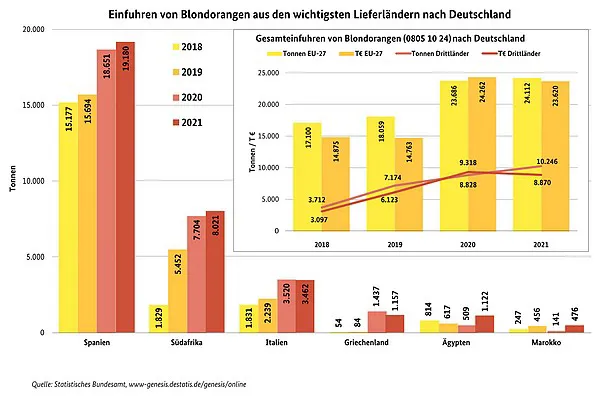Spanish Navelinas clearly dominated the blonde orange market. Navelinas from Italy, Delta Seedless, Valencia Late and Midknight from South Africa were available as well. In Munich, there were Newhalls from Portugal as well. Thanks to their low prices, imports from overseas in particular were often sold quickly, according to the latest BLE market report. In isolated cases, they became more expensive in the course of the week as a result of dropping volumes. Overall, sales were fairly slow.

Meanwhile, the Advent season has had a positive effect on demand. Nevertheless, prices changed only rarely, even though large-caliber Spanish Navelina in particular was quite popular. First Washington Navel from Turkey as well as Navelina from Greece should be available soon. Regarding blood oranges, the first Italian Moro arrived. In Hamburg, they cost €23 per 7-kg crate, considerably more than at the time of the season a year ago, when about €14 per 7-kg crate had to be paid. In the Hanseatic city, the fruits were not yet convincing with regard to their organoleptic properties.
The products offered in size 6 were too pale in color, but their taste was quite appealing. In Munich, too, the items had to be paid significantly more than 2021, but this did little to harm the uptake. The first Italian Tarocco also already appeared there. First Cara Cara from Spain were handled in Hamburg at 13 to 16, - € per 7 kg.
Apples
An unexciting marketing characterized the week. Supply and demand were sufficiently aligned. Domestic offers continued to lead the way, followed by Italian and French items. Shipments from the Netherlands, Belgium and Poland did not go beyond a supplementary status.
Pears
Italian Abate Fetel and Santa Maria predominated, Williams Christ of the same origin had lost importance. Turkish Santa Maria played a greater role, and native Conference and Alexander Lucas also had some relevance. In Cologne there was Belgian Me Amore which was handled at 2,- € per kg.
Table grapes
The presence of Peruvian imports apparently expanded. Crimson and Thompson Seedless in particular gained importance. Red Globe also became more important. The first South African Prime Seedless joined the range, in which Brazilian products were now also established. Prices of Italian and Spanish lots mostly dropped.
Smaller citrus
Clementines predominated and came almost exclusively from Spain. Italian and Moroccan products rounded out the offerings. For satsumas, only Turkish imports could be accessed. In the case of mandarins, the Italian season began with the first Shipments arriving in Munich, complementing the expiring South African offerings.
Lemons
Spanish Primofiori and Turkish Interdonato largely shared the action. There were occasional Italian and Greek deliveries as well. Business was slow, but the cold weather certainly intensified demand.
Bananas
Supply and demand generally balanced each other out sufficiently. Nevertheless, prices developed inconsistently. In Frankfurt, they remained mostly stable. In Cologne, second brands from Costa Rica became cheaper at the start of the week. In Hamburg, delayed ship arrivals caused an undersupply.
Cauliflower
French and Italian deliveries dominated the scene. Shipments from Spain, Belgium and the Netherlands did not exceed a supplementary character. Domestic goods had almost completely disappeared from the business. In Hamburg, the Italian offers were too high priced.
Lettuces
Belgian offers had a firm grip on the lettuce scene. In some cases, the price of lettuce increased due to the fact that it was bought in. Heavy heads were the most popular. Iceberg lettuces came exclusively from Spain. Deliveries weakened slightly. As a result of improved accommodation, sellers were able to increase their prices at times.
Cucumbers
Spanish cucumbers now almost has a monopoly, locally supplemented by supplies from Greece, Belgium and Morocco. The supply was not uniform locally. Prices fluctuated during the week, ending in stable but slightly lower levels.
Tomatoes
A varied assortment continued to be available, in which the end of the Central European season slowly became apparent. In the main, imports from Benelux and partly also Morocco steadily lost relevance. On the other hand, imports from Spain, Turkey and, in some cases, cherry tomatoes from Italy gradually gained in importance.
Sweet peppers
Partly due to the public holidays, supply was unsteady, especially towards the weekend. This had an impact on the prices for all color varieties. Red pepper supplies from Turkey followed this trend. Only green peppers remained at the level of the previous week in terms of total prices.
Source: BLE
